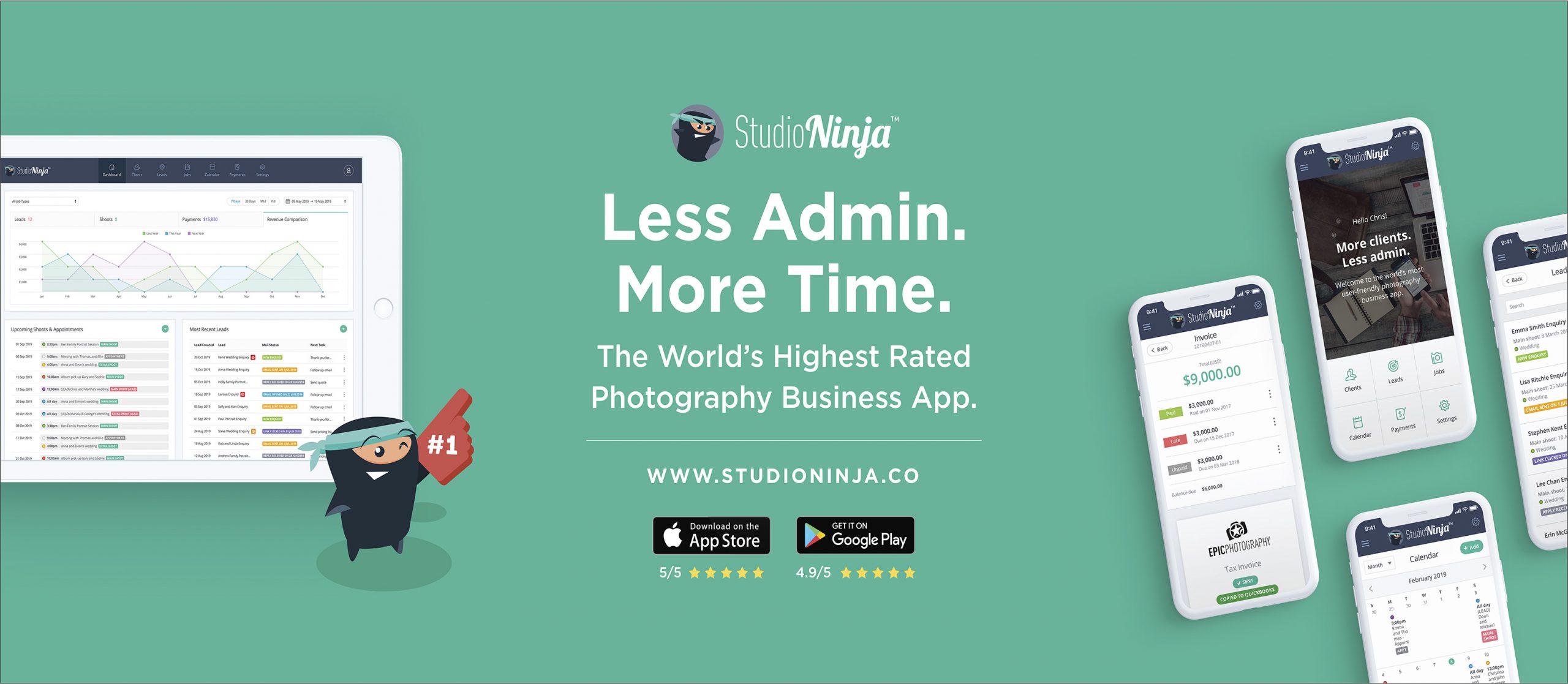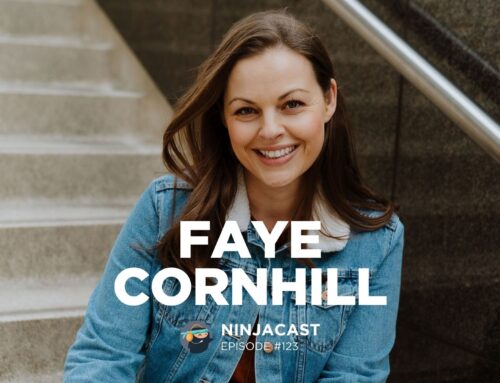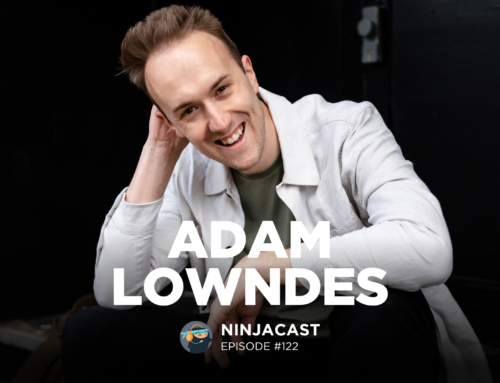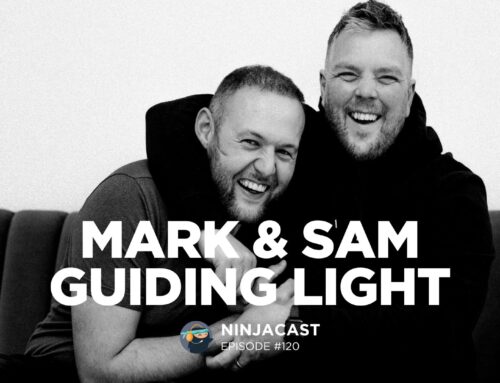029: Kate & Brent – How to Create a Strong Brand & Build Amazing Relationships with Your Clients
May 20, 2021
“Allow technology to work for you. You would be crazy not to let a software like Studio Ninja do it all for you”
KATE & BRENT
Hey everyone! It’s Sally here, from Studio Ninja. Today’s episode is all about Kate & Brent from Training by Lumiere.
Kate and Brent Kirkman offer a rare combination of a couple who shoot all three disciplines of photographic stills, cinematic films and aerial footage. They are both Sony Europe Imaging Ambassadors and as a creative team they work completely in sync with each other and with their clients, providing a single approach to shooting and directing, light and location and the final results that are crafted with the same style and finish.
They describe their style as ‘fine art storytelling’ because what matters to them is the ability to capture natural emotion and human connection in a stylish and creative way. They use their unique vision and years of experience to deliver work that is genuine, beautiful and artistic. Work that stands out but also stands the test of time.
Check out some of the biggest points from Kate & Brent’s interview below:
In terms of photographers that are new to the industry that just think, “Where do I being?” What is your best piece of advice for them?
Kate:
Okay, so I was very much somebody who came into the industry as a hobbyist, and I think that’s in lifestyle, the project is very, very, very common. Now the reason there is such a problem with impostor syndrome in photography is because most of us don’t have or don’t do any real kind of apprenticeship. You know, we don’t go and spend a year or two years with a photographer and learn the trade. People working more commercially studio-driven do, because it’s the only way they’re ever going to really make it. But the entrance to the industry is very easy for the area we are working, and that’s a good and a bad thing because it means that you can say you are a professional photographer and go out and put a website up and start working.
Kate:
And to a certain extent I did it. For example, I called myself a natural light photographer proudly on my website for the first two years, out of fear of artificial lighting. I turned it into a positive but I knew in my heart that I was frightened of this, so that’s my way of stopping somebody asking me about using flash photography.
Kate:
I’ve always, the analogy I’ve always given is a jigsaw puzzle. I think photography is a jigsaw puzzle and when you start out there’s a lot of gaps. There’s a lot of pieces missing, and every bit of knowledge is another jigsaw piece, and knowledge is confidence, and confidence is great photography. So it does come back to learning your craft, and the biggest, biggest thing is being able to see light.
Kate:
Now, it’s as simple as saying the ones, you nodded, so the people who know they see light know because you’re haunted by it after then. Those moments you’re in beautiful light without your camera, it stops you dead, and I definitely know that there was a before and after light element to photography for me, so I don’t think you can learn it from books. I genuinely think you need someone to show you, but really take the time to learn your craft.
Brent:
Yeah, I mean, I think about when I first started out and I joined Kate and even when I was doing photography and I joined Kate on a few shoots as a third, not even a second or a third, and something went wrong with a second and Kate threw a camera at me and said, “Get the fireworks. I’ll be getting closer up,” or whatever it was, and that fear and that panic that just sets in going, “Help.” I think a good analogy is you wouldn’t get into a car and take on a 15 hour cross country journey if you were unsure about where things were and how the car operated.
Brent:
It’s the same with our cameras and our knowledge of the light and how to do things. If it’s instinctive and you know that you’ve got it down and it’s just going to come to you, if the situation changes, you’re immediately going to dial in things at second nature, it allows you to then just be creative as opposed to somewhat panicking inside about what the hell to do because your conditions have changed and your light has changed.
Brent:
It is so important to just give yourself all of the knowledge so that you don’t have that stress. You wouldn’t have that stress driving a car if you knew where everything was, which you do, and so I think it’s so important.
Kate:
There’s that, which is really, really important, is getting your practical photography training, and then the other side is the business side, and it is massive. We all know how many hours we spend in front of a screen as opposed to spending out in the field, and actually Brent literally had to drag me out of the stone age on so many fronts. I would say to people starting out, “it’s a completely different landscape in 2021 than it was in 2010 in terms of accounting software, in terms of studio management software.” And I can’t tell you enough that, get that streamlined and in place, so that’s probably the bit you’re least interested in doing. Get your website SEO sorted out because Brent’s done all of that for me, rebuilt my website for me, and it totally transformed inquiries and everything.
Kate:
It’s all the stuff we don’t become photographers to do, and I’m sure we’ll talk about this more, but you know, I can really explain to people the value of Studio Ninja because I paid someone a lot of money to do what Studio Ninja does for me. So, I’m sure we’ll-
Brent:
Go on, go for it.
Kate:
Well, it’s, you know, in terms of, I think it’s generally a three year window for most businesses to go from kind of just trying to make it to it going crazy. It’s quite common, when I speak to photographers, that it really, really happens, and for me it was by year three I was crazy busy. I still had young kids and I couldn’t do it all, and you can never do it all. Now there’s a lot of software which means, my god, you can get close.
Kate:
Still say you need to have an amazing accountant, 100%, so I had what I called a studio manager, and she was actually a bride of mine who came to pick up her wedding album and said, “Okay, you look shattered.” You know? And I was like, “I am.” And she said, “Well, listen,” she’d left her kind of full-time job and she was going to do kind of remote PA-ing, and she lived relatively local, and she said, “I’m happy to do a few hours a week for you.”
Kate:
And I was like, “Great, brilliant.” So she started and she was like, “Oh my god,” quite quickly unearthed I had gone over the bar threshold and was about to get fined. I mean, you know, small but massive things, so she became very, very important to me, and she was doing my contracts, she was getting my documentation ready for the weddings. She was basically doing all of the admin, and I was paying her-
Brent:
A lot.
Kate:
A lot. And one of the things that happened with Brent is when he came in, he was like, “Come on, Kate. Your costs are too high in the business. You’re a very profitable business,” but actually cost base was high because I always had a book keeper, and so Brent looked into all of it and we’ve tried different studio management software over the years, I have, and none of them have replaced a Becky. And then Studio Ninja, I have to say, I mean, it’s genuinely from my heart how much I love this software because it does what a human does but better. It’s more efficient. You can rely on it. The time it has saved and the money, so it’s not just, I know time is money but genuinely from the heart it’s just been a transformative part of our business. We could not live without it, could we?
Brent:
Yeah. I mean, when I came in and Kate was doing all of the stuff, and she talks about the stone age, having 25 years in IT, I looked at the business and the businesses that we were going to create together, and just said, “God, there’s so much more efficiency through technology that we need to embrace here.” I mean, that’s what I spent my life doing for 25 years, so I just started to strip out things and replace them with technology and data, and Kate spoke about having another assistant which, when she said, “Oh, I’ve found this system and this is what I’m using.” And I looked into it and it was so complex even me, with the IT knowledge, I was like, “This is just kind of,” yes, it probably worked very, very well.
Brent:
But my gosh, you need a manual that thick to just kind of wrap your head around it, and I remember Kate coming and saying, “Oh, I’ve heard about this software called Studio Ninja. Will you check it out for me?” So she hands it across to me and I started to look through it and I went, “Oh my gosh. It’s easy, it’s intuitive.” I kind of looked at it as a, kind of reminded me a bit like Apple. It’s nice and clean, interface, it was simple to understand.
Brent:
I said, “Yeah, this is really good. We really need to look into this.” And so that’s, yeah, and my gosh, I love it, because we’ve been away in Croatia and it’s been working away and we’ve signed work while lying on a boat at sea, and just doing something-
Kate:
Yeah, take a deposit, they’ve signed it, so they’ve approved a quote, they’ve paid the deposit, and signed the contract, while we’ve been out on a boat during the day. You know what I mean? You’re like, “This is amazing.”
Brent:
And for a Royal Palace wedding, so we were like, “Yeah, this stuff is really good.” You know, it made that, because we run the business together, there’s no down time, and board meetings are in the bath, on the bed, at the breakfast table, we discuss business constantly, and so when we did go away for a holiday, it was just incredible to … you know, we didn’t have a studio manager anymore, and so it was like, “Okay, what are we going to do?” And while we were on holiday it was like, “Wow, actually, a little automated system is sitting there doing the work for us.” It gave us a holiday, that’s for sure.
Kate:
And I have to say for those photographers who haven’t had Studio Ninja during coronavirus, with having to move weddings, I cannot imagine the hell.

Photographers out there that may be just starting out, or actually maybe have thought about branding seriously, and they put their logo on a white background and said, “This is me.” Where do they begin in finding out who they are and who they want their brand to be?
Kate:
A great, brilliant question. There’s really two elements to a brand and the first part is actually the thought process, the thinking about who you are, what you stand for. Let’s bring it to your brand values, what you stand for. And then it’s how you communicate and how you sound, and those are words. People can actually write them down and in the brand agency I worked for we had four brand values and we had four personality values, so I’m not a big, loud personality, so it would be really strange if my brand kind of sounded or looked like that.
Kate:
And actually, we stand as certainly the KHS brand, for making people feel at ease. It is so much about making people feel comfortable with photography, because we don’t attract … the easiest way to put this into today’s context is we don’t attract the kind of influencer, social media girls or men, who are quite comfortable with who they are, and loud. That is not who comes to us. People come to us who aren’t aware of how beautiful or gorgeous they actually are, or they have concerns that having spent a year planning a wedding their vision of having, wanting it to look actually come to life, and so it’s a lot to do with empathy, and reassurance, and trust.
Kate:
But that’s not for everyone. There’s so many different personality types on the market, so number one is try and work out what you stand for and who you are as a person and as a business, because they are connected with photography. And then the second thing is to bring that to life through what you’d call a visual toolkit of which a logo is such a tiny part of it, yet most photographers only have logos, and just to put it absolutely clear, and this is where most photographers put their head in their hands, and I work with one of the best branding, world renowned designers. He was incredible, he recently died, he was called Martin Abina. He’s incredible.
Kate:
And he said, “Listen, a logo is merely a trigger. A logo, when you see it, if you know it, triggers an emotion. Positive or negative. Or it triggers nothing because you have no familiarity with the actual brand.’ And so he said, “So actually, a logo, in its simplest form, needs to work on a pencil.” If you can’t read your logo on a pencil, so for example if it’s surrounded by dandelion clocks or who knows, the job of a logo is not to kind of try to represent who your as a photographer at all. All of that has to come into the design work, the way you speak, your color pallets, so it’s quite a big subject as you can see, but two areas.
Kate:
Number one is get your positioning right and number two is work out what that looks visually.

If you could start your careers all over again, is there anything you’d do differently?
Kate:
Yeah, Studio Ninja.
Brent:
Yeah.
Kate:
I don’t think it existed, actually. Well, it did, because that was 2009, ’10, but it should be like a primary purchase.
Brent:
Yeah, it should be the main thing that when you set up your studio as part of your production, Studio Ninja should be integral to that and then your accounting software collect into that, and sort to email, and sort to website, but 100%, and I say the other one would be put the effort into understanding and working more with SEO for your website. I think a lot of people put so much emphasis on getting a great looking website but it’s going to be an amazing website will just be standing on the edge of the cliff, shouting into a big, wide, open ocean, with no boats out there to hear you.
Brent:
Yes, I’d like to say talk to our, in terms of branding, that those are very, very critical. But I think the biggest element to the website would be making sure that the SEO works, because you need to tell Google who you are in words. Images won’t necessarily explain who you are for this big old search engine that’s sitting there crunching away all the time, so if you want to be found, SEO has to be done correctly.

Thank you!
Thanks again to you all for joining us and a huge thanks to Kate & Brent for joining us on the show!
If you have any suggestions, comments or questions about this episode, please be sure to leave them below in the comment section of this post, and if you liked the episode, please share it using the social media buttons you see at the bottom of the post!
That’s it for me this week, I hope you all enjoyed this episode.
See you soon,
Sally

About Kate & Brent
Kate and Brent Kirkman offer a rare combination of a couple who shoot all three disciplines of photographic stills, cinematic films and aerial footage. They are both Sony Europe Imaging Ambassadors and as a creative team they work completely in sync with each other and with their clients, providing a single approach to shooting and directing, light and location and the final results that are crafted with the same style and finish.
They describe their style as ‘fine art storytelling’ because what matters to them is the ability to capture natural emotion and human connection in a stylish and creative way. They use their unique vision and years of experience to deliver work that is genuine, beautiful and artistic. Work that stands out but also stands the test of time.





